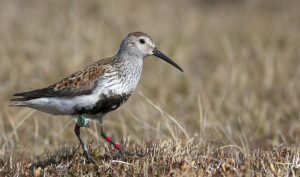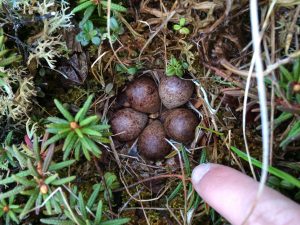Alaska is a birders paradise. Hundreds of bird species migrate to Alaska every year to raise their young in the summer and feast on the abundant and rich diversity of plants and animals. Some of these birds include owls, cranes, shorebirds, songbirds, and swans. Some birds come as far as the other side of the world in Antarctica and return when the  Alaska summer ends.
Alaska summer ends.
When hiking through the backcountry, one can be unaware of the beautiful diversity of birds in their surroundings.
Certain characteristics such as the color and shape of their head, beak, wings, chest, and feet along with a bird’s song are like fingerprints that aid in identification.
Bird lovers often use these characteristics to quickly identify them in the field.
Migratory Birds in Alaska
One such birder is Ben Lagasse who came to Alaska for his third summer to study shorebirds as part of a long-term research project run by the U.S. Fish and Wildlife Service.
Summer of 2016 included surveys of breeding shorebirds on the Yukon-Kuskokwim Delta, documenting breeding shorebird ecology in Barrow, and some post-work backpacking around the Atigun Pass and Galbraith Lake areas in the Brooks Range.
It was a pleasure to have hosted Ben at Base Camp Anchorage hostel while he prepared for the summers research outings. Many of his mornings were often spent sipping a cup of coffee while preparing light-level geolocator tags. These tags were then used to document the migration ecology and winter distribution of Dunlin (see above picture) throughout the circumpolar arctic.
We send a big appreciation to Ben and all the other passionate bird lovers out there who remind us of the rich diversity of birds around us and the important role they play in our environment.
Here are a few birding moments Ben captured from this summer. For any ornithologists, birdwatchers, and nature lovers, an Alaskan summer has no shortage of opportunities for wildlife viewing as millions of birds flock north as part of their ancient annual migrations. See you next summer Ben!




Hello
I am a radio journalist in Australia doing some research on the failure of the Short Tailed Shearwater flock to arrive as usual in southern Australia. I hope you may be able to direct me to a contact with a birder/scientist who may have some information about the conditions in which these birds were living in their stay over the northern summer.
It appears from he little evidence we have that the birds may have struggled to find sufficient food for their long flight and have either, in reduced numbers, gone straight to Antarctica to fatten, or have simply not made the distance. In the latter case we may be missing some hundreds of thousands of birds. In the former case, we will still be missing a whole year of breeding which will impact on the survival of the species, considering all the other challenges they are facing.
I am hoping for some information about the fish stocks on which they would have relied in the last months: are, as some have suggested, the fish swimming deeper as a result of warming surface temperatures and are therefore out of reach of the birds. Or, perhaps, fish numbers may have collapsed.
I hope you can direct me to someone who may have some information pertinent to this troubling case.
Thank you, and I look forward to your reply
Kind regards
Jane Richter
Triple UFM
Shoalhaven Community Radio
Nowra, NSW, Australia
Hello there,
I apologize for such a late reply. I forwarded your message to the Anchorage Audubon society. Hopefully they might be able to direct you to the right person. I gave them your email. If you would like to also contact them directly, they can be reached at info@anchorageaudubon.org
good luck
Ole